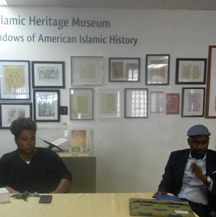Though not a Muslim, Dr. Mia Carey joined Dr. Muhammad Fraser-Abdur Rahim in leading a lively multi-racial, multi-generational, and religiously diverse discussion on the Black Muslim experience in the United States. The discussion, says Carey, unpacked White supremacy “by retelling Black Muslim stories from their own eyes and not that from others.”
As the dialogue unrolled, Amir Muhammed, cofounder of the Islamic American Heritage Museum, which hosted the two-hour discussion, reminded the full room audience that Muslims have been in the what has become the United States even before Estevanico (1500?-1539), the first non-Native American to visit what is now Arizona and New Mexico.
What can be viewed as a twist of historical fate, Carey and Rahim met while conducting an archeological dig at 3324 Dent Place, NW, the site of the former Georgetown, District of Columbia home of Yarrow Mamount (1736-1823). A practicing Muslim, an enslaved Mamount was brought to Maryland, won his freedom, and became perhaps the most prominent African American Washingtonian in the early 1800s.
The archeological exploration was the first of an enslaved African-American Muslim. Currently a $3 million townhome sits on the property, but there are plans to place a plaque on the site to acknowledge Mamount’s place in history and the struggles he lived with in a nation where many consider White people to be supreme.
Muslims, like Mamount, arrived from West Africa up until about 1865.Then says Rahim, there was a “40-60 year gap between African Islam and African-American Islam.”
Islamic hybrid movements such as the Moorish Science Temple developed in the early 1900s and Wallace Fard Muhammad reinvigorated the spread of Islam with the founding of the Nation of Islam (NOI) around 1930. Elijah Muhammad succeeded Fard and descendents of enslaved Africans continued to be the face of Islam in America.
“Southeast Asians are the now the largest block, replacing African-Americans,” says Rahim. “The shift took place around 2015,” he continued.
Unpacking White Supremacy in the Black Muslim Experience
Praising the Past


Despite the media controversies and Facebook banning the current leader of the NOI, Louis Farrakhan, Rahim says, as of today, “men on the Nation of Islam have not carried out acts to terrorism.” Rahim is an Assistant Professor at the Department of Intelligence and Security Studies at The Citadel.
Despite the media controversies and Facebook banning the current leader of the NOI, Louis Farrakhan, Rahim says, as of today, “men on the Nation of Islam have not carried out acts to terrorism.”
Carey, who works for the National Park Service, says her job is to “unpack stories that people otherwise would not know.” Did you know, she said, that “Dr. King was a gun owner and had a stockpile of guns in his house?” As a non-Muslim, she says she enjoyed working on the Mamount project, because, “I love Black people.”
Ironically, when unpacking the history of the building now housing the Islamic museum, Amir Muhammad explained that the building was once owned by “the same family that freed Mamount.” Since about 1967, many Muslim businesses had rented the building from the family until Muslims purchased the building in 1973.
Subsequently, the building has housed a number of Muslim businesses and institutions including Shabazz bakery, Sister Clara Muhammad School, and now the museum. “With gentrification taking foot at the museum’s doorstep," Muhammad noted that its survival has become more significant.
The museum is closed Mondays, open 11a to 5p Tuesday through Saturday, and open Sunday from 12p to 5p at 2315 Martin Luther King Ave. SE. Entrance fees are $7 for adults, $5 for seniors and students, and $3 for children 6-12.Groups of 10 or more get a discounted rate of $3 per guest. To learn more, call 202 678-6906.
Note:
America's Islamic Heritage Museum
5th Annual Iftar and Fundraiser
Bamian Restaurant
5634 Leesburg Pike
Falls Church, VA
Thu, May 16, 7p-10p, $50
Despite the media controversies and Facebook banning the current leader of the NOI, Louis Farrakhan, Rahim says, as of today, “men on the Nation of Islam have not carried out acts to terrorism.”
Carey, who works for the National Park Service, says her job is to “unpack stories that people otherwise would not know.” Did you know, she said, that “Dr. King was a gun owner and had a stockpile of guns in his house?” As a non-Muslim, she says she enjoyed working on the Mamount project, because, “I love Black people.”
Ironically, when unpacking the history of the building now housing the Islamic museum, Amir Muhammad explained that the building was once owned by “the same family that freed Mamount.” Since about 1967, many Muslim businesses had rented the building from the family until Muslims purchased the building in 1973.
Subsequently, the building has housed a number of Muslim businesses and institutions including Shabazz bakery, Sister Clara Muhammad School, and now the museum. “With gentrification taking foot at the museum’s doorstep," Muhammad noted that its survival has become more significant.
The museum is closed Mondays, open 11a to 5p Tuesday through Saturday, and open Sunday from 12p to 5p at 2315 Martin Luther King Ave. SE. Entrance fees are $7 for adults, $5 for seniors and students, and $3 for children 6-12.Groups of 10 or more get a discounted rate of $3 per guest. To learn more, call 202 678-6906.
Note:
America's Islamic Heritage Museum
5th Annual Iftar and Fundraiser
Bamian Restaurant
5634 Leesburg Pike
Falls Church, VA
Thu, May 16, 7p-10p, $50
Advertisers | Contact Us | Events | Links | Media Kit | Our Company | Payments Pier
Press Room | Print Cover Stories Archives | Electronic Issues and Talk Radio Archives | Writer's Guidelines






